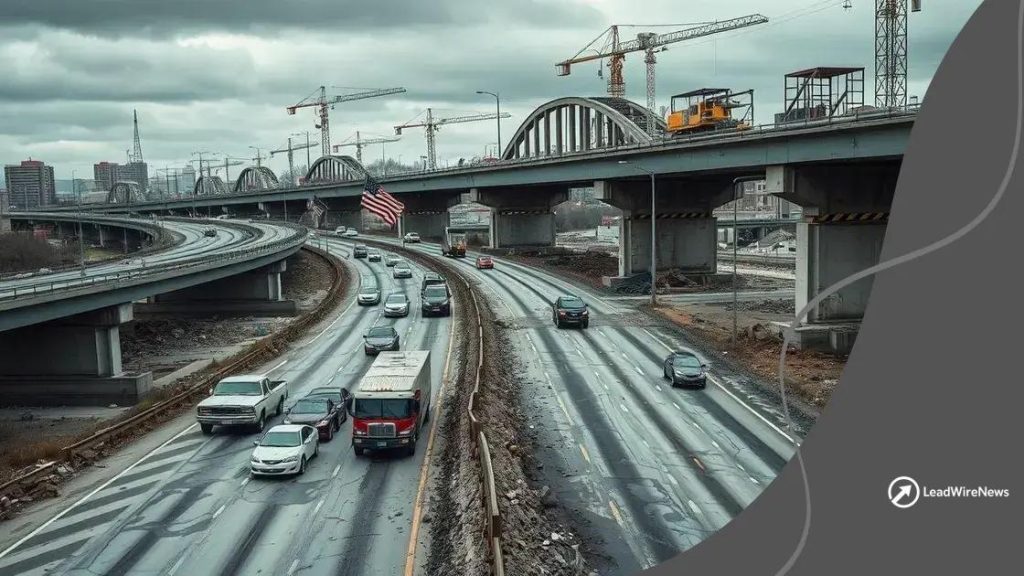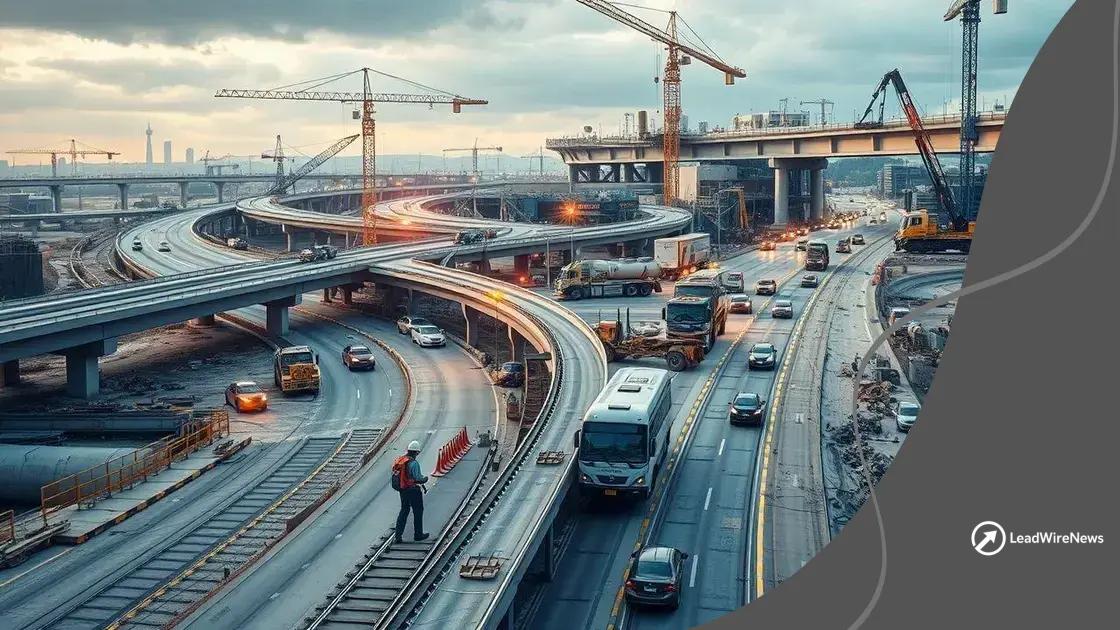The current state of US infrastructure: an urgent need for change

Anúncios
The current state of US infrastructure is characterized by aging structures and insufficient funding, necessitating modernization through technology and innovative funding strategies to ensure safety and efficiency.
The current state of US infrastructure is raising alarms across the nation. With crumbling roads and outdated bridges, it begs the question: what needs to be done to secure a better future?
Anúncios
Overview of US infrastructure challenges
Understanding the current state of US infrastructure is essential. There are significant challenges that we must address to ensure safety and modernization. With many roads and bridges in disrepair, it’s clear that action is needed.
The effects of an outdated system extend beyond mere inconvenience. For instance, traffic congestion due to poor road conditions can lead to economic losses. In addition, aging bridges pose a threat to safety for millions of drivers each day.
Key Issues Facing US Infrastructure
Major challenges include:
Anúncios
- Inadequate funding for maintenance and new projects
- Environmental impacts and sustainability concerns
- Technological gaps in infrastructure management
- Growing population and increasing demand for services
Furthermore, climate change presents additional risks, making it crucial for infrastructure to be resilient. Extreme weather events can damage existing structures and create new vulnerabilities. Thus, adapting to these changes is imperative for future planning.
Economic Considerations
The economic implications of poor infrastructure are staggering. Delays due to traffic congestion alone cost billions in lost productivity each year. Upgrading our infrastructure can stimulate job creation and improve overall efficiency.
Investing in high-quality roads, bridges, and public transit systems leads to immediate benefits. The ripple effects enhance the economy, aiding in smoother transportation of goods and services.
Overall, addressing these challenges head-on will require collaboration between government, private sectors, and the public. By recognizing the urgent need for change, we can pave the way for a more efficient and safe infrastructure.
Impact of aging infrastructure on economy
The impact of aging infrastructure on the economy is significant and often underestimated. Poorly maintained roads and bridges lead to delays that affect not only individual drivers but also the larger economic system. Every delay costs money, both in wasted time and in decreased productivity.
As infrastructure ages, maintenance costs rise. Local governments struggle to allocate funds for repairs, which can result in increased taxes or cuts to other essential services. This creates a cycle where economic growth is stunted due to a lack of reliable transportation networks.
Economic Consequences of Deteriorating Infrastructure
The economic consequences include:
- Increased transportation costs for businesses
- Loss of revenue due to delayed deliveries
- Higher insurance and maintenance costs for vehicles
- Job losses in sectors reliant on logistics
Furthermore, the state of our roads and bridges plays a crucial role in attracting new businesses. Areas with strong infrastructure often see more investment, while regions with poor conditions can struggle to grow.
The Domino Effect on Communities
Aging infrastructure doesn’t just affect large companies; it also impacts small businesses and local communities. For example, if a major road is in disrepair, traffic can be diverted, affecting shops and services reliant on customers passing by. Economic vitality in these communities can decline rapidly due to lack of visibility and access.
Ultimately, improving infrastructure is not just an investment in roads and bridges; it is an investment in the future of our economy. By prioritizing these repairs, we enable growth, increase efficiency, and improve quality of life for everyone.
Significant projects aimed at improvement

There are several significant projects aimed at improvement of US infrastructure. These initiatives address the pressing needs for modernization and safety across the nation. By focusing on key areas, these projects aim to enhance efficiency and reliability.
One of the notable projects is the enhancement of the interstate highway system. This involves upgrading road surfaces, improving signage, and implementing advanced traffic management systems. These updates are essential not just for safety but also for reducing travel times.
Key Projects and Innovations
Several major projects include:
- Replacement and repair of aging bridges nationwide
- Expansion of public transit systems in major cities
- Investment in smart traffic lights and sensors
- Development of sustainable transportation options like bike lanes
Furthermore, the renewal of rail systems is gaining momentum. This includes modernizing freight and passenger rail services to improve speed and capacity while reducing congestion on highways.
Funding and Support
Funding for these initiatives often comes from a mix of federal, state, and local sources. Public-private partnerships are increasingly important, allowing for innovative financing solutions that ensure these projects can move forward effectively. By engaging the community and stakeholders, project backers can create a sense of shared investment in these improvements.
By focusing on projects that emphasize safety, efficiency, and sustainability, the US is taking critical steps towards an upgraded infrastructure that will benefit all Americans. This proactive approach is vital for supporting future growth and economic stability.
Role of technology in modernizing infrastructure
The role of technology in modernizing infrastructure is becoming increasingly vital as cities and states address aging systems. Technology not only improves efficiency but also enhances safety for users. Implementing new technologies reshapes how we interact with and maintain our infrastructure.
One major technological advance is the use of smart sensors. These devices monitor traffic patterns, structural integrity, and environmental conditions. By collecting real-time data, city planners can make informed decisions and quickly address issues before they escalate.
Innovations in Infrastructure
Some innovations driving modernization include:
- Smart traffic lights that adapt to real-time traffic flow
- Advanced materials that extend the lifespan of bridges and roads
- Automated drones for structural inspections
- Digital platforms for crowd-sourcing feedback from citizens
Moreover, the integration of building information modeling (BIM) allows for improved project planning and management. This technology enables detailed 3D models, which help engineers and architects identify potential problems early in the design phase.
Green Technology Integration
Additionally, technology is facilitating the integration of green solutions. Sustainable materials, renewable energy sources, and smart grid technology are being woven into the fabric of new infrastructure projects. These practices not only help the environment but also save costs over time.
With the right technology, infrastructure can become more sustainable and resilient, allowing it to effectively serve communities for years to come. The ongoing evolution of technology offers exciting possibilities to tackle the challenges of the future.
Funding strategies for infrastructure development
Funding strategies for infrastructure development are crucial for ensuring that projects can move forward efficiently. With the vast costs associated with renovation and construction, effective funding sources are vital to meet the nation’s needs. Various funding methods are emerging to support infrastructure projects.
One primary source of funding comes from federal and state governments. Federal grants and loans help provide necessary capital for large-scale projects. States often have their own budgets specifically allocated for infrastructure improvement.
Public-Private Partnerships (PPPs)
Public-Private Partnerships (PPPs) are increasingly popular for financing infrastructure. These collaborations between government entities and private companies can leverage private investment and expertise to enhance public projects. They often result in:
- Shared risks and responsibilities
- Innovative approaches to construction
- Increased efficiency and speed in project completion
- Long-term maintenance agreements
Another innovative funding method is the use of infrastructure banks. These institutions can provide low-interest loans to support major infrastructure projects with the goal of revamping existing systems and building new ones.
Community Engagement and Crowdfunding
Local governments are also turning to community engagement strategies, where residents participate in financing initiatives. Crowdfunding campaigns have become a way to raise small amounts of money from a large number of people. This approach not only engages the community but also creates a sense of ownership over local projects.
In conclusion, diverse funding strategies, from traditional government budgets to innovative community involvement, are essential for the future of infrastructure development. By exploring these various funding sources, we can create and maintain an efficient, safe, and modern infrastructure system.
FAQ – Frequently Asked Questions about US Infrastructure
What are the main challenges facing US infrastructure today?
The main challenges include aging structures, inadequate funding, increasing demand, and the need for modernization and safety improvements.
How does technology contribute to improving infrastructure?
Technology enhances infrastructure through smart sensors, advanced materials, and digital planning tools, leading to more efficient and safer systems.
What funding strategies are used for infrastructure development?
Funding strategies include federal and state grants, public-private partnerships, community engagement, and innovative financing like infrastructure banks.
Why is community involvement important in infrastructure projects?
Community involvement fosters a sense of ownership and ensures that projects meet the needs of residents, leading to better outcomes.